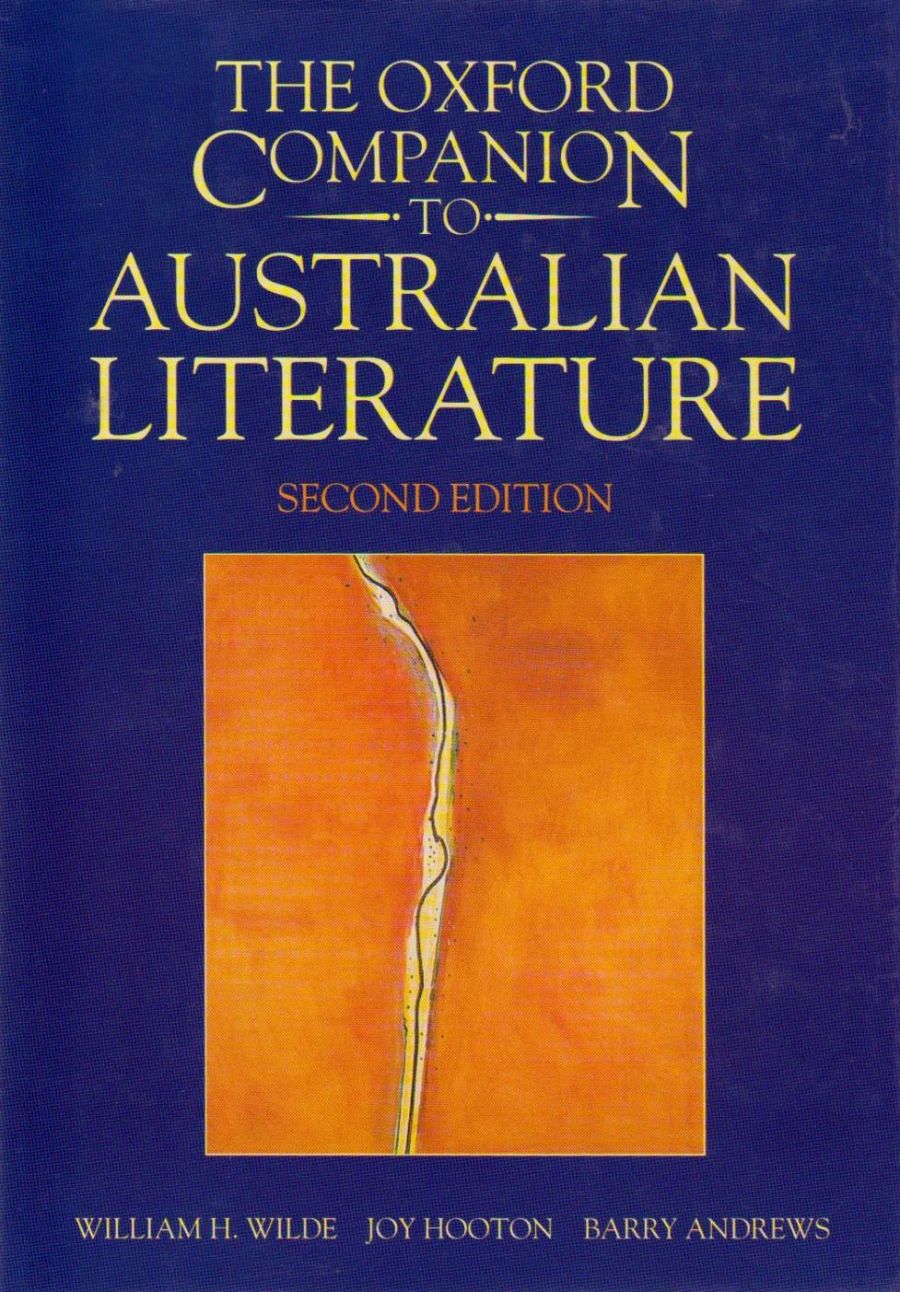
- Free Article: No
- Contents Category: Literary Studies
- Review Article: Yes
- Online Only: No
- Custom Highlight Text:
‘Those bastards at Oxford,’ Barry Andrews fulminated ten years ago (he had in mind one or two in particular) ‘are trying to make us cut 200,000 words from the book!’ The ‘book’ was the first edition of the estimable The Oxford Companion to Australian Literature. The ‘bastards’ had miscounted and the text survived more or less in full. Now, nine years after its first publication, the Companion has appeared in a revised edition with an extra 200,000 words, not there by way of compensation, but rather to cope with the brilliantly successful publicity campaign for Australian writing during the last decade. Bill Wilde and Joy Hooton remain as editors, Barry having died in 1987.
- Book 1 Title: The Oxford Companion to Australian Literature (Second Edition)
- Book 1 Biblio: OUP, $69.95 hb
Consider a sample page – 726 will do. After the tail-end of the ‘Strauss, Jennifer’ entry, and ignoring ‘Street, Jessie’ (cross-referenced to ‘Feminism and Australian Literature’), six entries occupy the page. None, strictly speaking, concerns a creative writer. Instead, we have the painter ‘Streeton, Sir Arthur’; Aboriginal linguist ‘Strehlow, T.G.H.’ and the political scientist, ‘Stretton, Hugh’. The other entries are on ‘Stream’, an avant-garde magazine which lasted for three months in 1931; ‘Strine’, ‘a term invented to represent the way Australians pronounce the word ‘Australian’; and ‘Stroke’, a poem sequence by Vincent Buckley, whose contents are summarised. All the entries are unobjectionable. The plot synopsis, for instance, is one of hundreds to be found in the Companion. They are there, of course, for the convenience of students, and for their teachers’. Nevertheless the page has a more diverse appearance than one might expect to find in a literary Companion.
Numerous key entries in the book are much longer than those sampled above. There are fine critical miniatures, such as Jeff Doyle’s on Peter Porter; admirable article-length pieces, for example eight pages by Bill Wilde and David Headon on ‘Aborigine in White Australian Literature’, or John Laird, who has more than ten pages for a survey of ‘War Literature’. There he refers to ‘Breaker’ Morant as a ‘minor poet’, yet elsewhere in the Companion the fellow has a column of his own. This is inconsistent, and polyvocalism is not perhaps the prerequisite for a Companion. Moreover, Morant appearsin the Lairdentry without benefit of a q.v. The editors should have been more careful. When E.G. Whitlam launched the first edition in Queen’s Hall at the State Library of Victoria in 1985, he found a q.v. reference to himself but then looked in vain for the full entry. Amends have been made and now – without clear warrant – he has almost a column to himself.
It is moot how far a Companion should offer value judgements as hostages to fortune, or more properly, to fashion. Whether they should any longer be part of criticism at large is a matter discussed in the conclusion of Harry Heseltine’s excellent piece (expanded since the first edition) on ‘Criticism’. Surveying the period 1964–88 (between the Geoffrey Dutton’s Literature of Australia and the Laurie Hergenhan’s Penguin New Literary History of Australia), Heseltine finds ‘enormous changes’ in Australian criticism, which -in those intervening years-had been thoroughly theorised, had learned to take full advantage of an ever more supportive scholarly infrastructure, had grown immeasurably in the professionalism of its practices and procedures. If it had forsaken anything, it was perhaps the exercise of evaluative judgment.
This is trenchant and unfashionable talk, but Heseltine guesses that revaluation’s tum will come again. When judgements concerning individual works and authors are ventured in the Companion, they have an extraneous air, usually feeling either too cautious or too fanciful. The description of Frank Moorhouse’s novel Grand Days as ‘reminiscent of Stendhal and Zola’ is not too cautious, at least in my judgement.
Sundry and unexpected pleasures are bountiful for the browser in this Companion. It is especially, perhaps, to nineteenth-century subjects and to the contextualising entries that one turns to for instruction and entertainment. Scholarship is leavened with good humour. Almost everywhere one finds a laudable fairness allied with patience, so that authors and subjects are seldom short-changed, nor are readers hurried on before their curiosity is satisfied. The obverse of this standard practice is that sometimes the editors, and their contributors, tell us more than we wanted to know. This is largely a function of a desire to be up-to-date which cannot sometimes help but appear merely modish. Too many living authors, already or bound to seem minor, are treated at a respectful length that could, in hindsight, look like misjudgment. Some of these writers may come to belong, as F.R. Leavis said of the Sitwells, more to the history of publicity than to that of poetry. Their entries in the Companion may then bear the unfortunate air of parody. It is, however, greatly to the credit of the editors that the bulk of this massive work of reference (and the sprightly first edition harboured within it) is likely to have a resilient and useful life. The Oxford Companion to Australian Literature may be a touch too reverential towards its subject, but has enriched its study.


Comments powered by CComment